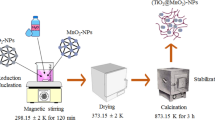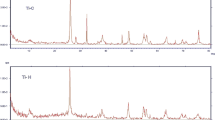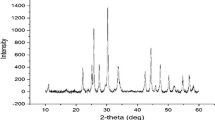Abstract
Spent sorbents in water treatment processes have potential risks to the environment if released without proper treatment. The aim of this work was to investigate the potential regeneration of commercially prepared nano-TiO2 (anatase) for the removal of Pb (II), Cu (II), and Zn (II) by pH 2 and ethylenediaminetetraacetic acid (EDTA) solutions. The percent of metal adsorption/desorption decreased with the increasing number of regeneration cycles, and the extent of decrease varied for each metal. Competitive effects were observed for the adsorption/desorption of different metals when the nano-TiO2 was regenerated by EDTA solutions. Nano-TiO2 was able to treat simulated metal polluted water with greater than 94 % adsorption and greater than 92 % desorption after four cycles of regeneration using pH 2 solution. These results demonstrated that nano-TiO2 can be regenerated and reused using pH 2 solution compared to an EDTA solution for aquatic metal removal, which makes nanosorbents promising and economically and environmentally more attractive in the application of water purification.




Similar content being viewed by others
References
Cruz Viggi C, Pagnanelli F, Cibati A, Uccelletti D, Palleschi C, Toro L (2010) Biotreatment and bioassessment of heavy metal removal by sulphate reducing bacteria in fixed bed reactors. Water Res 44(1):151–158
Davis JA, Kent D (1990) Surface complexation modeling in aqueous geochemistry. Rev Mineral Geochem 23(1):177–260
Debnath S, Nandi D, Ghosh UC (2011) Adsorption–desorption behavior of cadmium(II) and copper(II) on the surface of nanoparticle agglomerates of hydrous titanium(IV) oxide. Journal of Chemical & Engineering Data 56(7):3021–3028
Deng L, Su Y, Su H, Wang X, Zhu X (2007) Sorption and desorption of lead (II) from wastewater by green algae Cladophora fascicularis. J Hazard Mater 143(1–2):220–225
Doula MK, Ioannou A (2003) The effect of electrolyte anion on Cu adsorption–desorption by clinoptilolite. Microporous and Mesoporous Materials 58(2):115–130
Engates KE (2010) Characterization, sorption, and exhaustion of metal oxide nanoparticles as metal adsorbents. Ph.D., The University of Texas at San Antonio
Engates K, Shipley H (2011) Adsorption of Pb, Cd, Cu, Zn, and Ni to titanium dioxide nanoparticles: effect of particle size, solid concentration, and exhaustion. Environ Sci Pollut Res 18(3):386–395
Fan Q, Shao D, Lu Y, Wu W, Wang X (2009) Effect of pH, ionic strength, temperature and humic substances on the sorption of Ni(II) to Na–attapulgite. Chem Eng J 150(1):188–195
Fu F, Wang Q (2011) Removal of heavy metal ions from wastewaters: a review. J Environ Manage 92(3):407–418
Gao Y, Kan AT, Tomson MB (2003) Critical evaluation of desorption phenomena of heavy metals from natural sediments. Environ Sci Technol 37(24):5566–5573
Gao Y, Wahi R, Kan A, Falkner J, Colvin V, Tomson M (2004) Adsorption of cadmium on anatase nanoparticles—effect of crystal size and pH. Langmuir 20(22):9585–9593
Gedik K, Imamoglu I (2008) Removal of cadmium from aqueous solutions using clinoptilolite: influence of pretreatment and regeneration. J Hazard Mater 155(1–2):385–392
Giammar DE, Maus CJ, Xie L (2007) Effects of particle size and crystalline phase on lead adsorption to titanium dioxide nanoparticles. Environ Eng Sci 24(1):85–95
Grossl PR, Eick M, Sparks DL, Goldberg S, Ainsworth CC (1997) Arsenate and chromate retention mechanisms on goethite. 2. Kinetic evaluation using a pressure-jump relaxation technique. Environ Sci Technol 31(2):321–326
Gupta VK, Rastogi A (2008) Sorption and desorption studies of chromium(VI) from nonviable cyanobacterium Nostoc muscorum biomass. J Hazard Mater 154(1–3):347–354
Guzman KAD, Finnegan MP, Banfield JF (2006) Influence of surface potential on aggregation and transport of titania nanoparticles. Environ Sci Technol 40(24):7688–7693
HachCompany (2008) Water analysis handbook. Hach, Loveland
Hashim MA, Mukhopadhyay S, Sahu JN, Sengupta B (2011) Remediation technologies for heavy metal contaminated groundwater. J Environ Manage 92(10):2355–2388
Hayes KF, Redden G, Ela W, Leckie JO (1991) Surface complexation models: an evaluation of model parameter estimation using FITEQL and oxide mineral titration data. J Colloid Interface Sci 142(2):448–469
Herbelin A, Westall J (1999) FITEQL 4.0: a computer program for determination of chemical equilibrium constants from experimental data. Department of Chemistry, Oregon State University, Corvallis
Hu J (2006) Fundamental investigation on removal and recovery of heavy metals from synthetic wastewater using magnetic nanoparticles. Ph.D., Hong Kong University of Science and Technology (Hong Kong)
Hu J, Shipley HJ (2012) Evaluation of desorption of Pb (II), Cu (II) and Zn (II) from titanium dioxide nanoparticles. Sci Total Environ 431:209–220
Hu J, Chen G, Lo IMC (2006) Selective removal of heavy metals from industrial wastewater using maghemite nanoparticle: performance and mechanisms. J Environ Eng 132(7):709–715
Katsou E, Malamis S, Tzanoudaki M, Haralambous KJ, Loizidou M (2011) Regeneration of natural zeolite polluted by lead and zinc in wastewater treatment systems. J Hazard Mater 189(3):773–786
Kim MS, Hong KM, Chung JG (2003) Removal of Cu (II) from aqueous solutions by adsorption process with anatase-type titanium dioxide. Water Res 37(14):3524–3529
Kobya M, Demirbas E, Senturk E, Ince M (2005) Adsorption of heavy metal ions from aqueous solutions by activated carbon prepared from apricot stone. Bioresour Technol 96(13):1518–1521
Lezcano JM, González F, Ballester A, Blázquez ML, Muñoz JA, García-Balboa C (2011) Sorption and desorption of Cd, Cu and Pb using biomass from an eutrophized habitat in monometallic and bimetallic systems. J Environ Manage 92(10):2666–2674
Li J, Hu J, Sheng G, Zhao G, Huang Q (2009) Effect of pH, ionic strength, foreign ions and temperature on the adsorption of Cu(II) from aqueous solution to GMZ bentonite. Colloids and Surfaces A: Physicochemical and Engineering Aspects 349(1–3):195–201
Machida M, Kikuchi Y, Aikawa M, Tatsumoto H (2004) Kinetics of adsorption and desorption of Pb (II) in aqueous solution on activated carbon by two-site adsorption model. Colloids and Surfaces A: Physicochemical and Engineering Aspects 240(1):179–186
Rao GP, Lu C, Su F (2007) Sorption of divalent metal ions from aqueous solution by carbon nanotubes: a review. Sep Purif Technol 58(1):224–231
Şengil İA, Özacar M (2009) Competitive biosorption of Pb2+, Cu2+ and Zn2+ ions from aqueous solutions onto valonia tannin resin. J Hazard Mater 166(2–3):1488–1494
Shipley HJ, Yean S, Kan A, Tomson M (2009) Adsorption of arsenic to magnetite nanoparticles: effect of particle concentration, ph, ionic strength, and temperature. Environ Toxicol Chem 28(3):509–515
Stone AT, Torrents A, Smolen J, Vasudevan D, Hadley J (1993) Adsorption of organic compounds possessing ligand donor groups at the oxide/water interface. Environ Sci Technol 27(5):895–909
Tratnyek PG, Johnson RL (2006) Nanotechnologies for environmental cleanup. Nano Today 1(2):44–48
Trivedi P, Axe L (2000) Modeling Cd and Zn sorption to hydrous metal oxides. Environ Sci Technol 34(11):2215–2223
US EPA (2009) Nanomaterial case studies: Nanoscale titanium dioxide (external review draft). US Environmental Protection Agency, Washington, DC
Vohra MS, Davis AP (1998) Adsorption of Pb (II), EDTA, and Pb (II)-EDTA onto TiO2. J Colloid Interface Sci 198(1):18–26
Yang JK, Davis AP (1999) Competitive adsorption of Cu (II)-EDTA and Cd (II)-EDTA onto TiO2. J Colloid Interface Sci 216(1):77–85
Yang JK, Lee SM (2005) EDTA effect on the removal of Cu (II) onto TiO2. J Colloid Interface Sci 282(1):5–10
Yang Y, Chen H, Pan G (2007) Particle concentration effect in adsorption/desorption of Zn(II) on anatase type nano TiO2. J Environ Sci 19(12):1442–1445
Zeng G, Pang Y, Zeng Z, Tang L, Zhang Y, Liu Y, Zhang J, Lei X, Li Z, Xiong Y, Xie G (2011) Removal and recovery of Zn2+ and Pb2+ by imine-functionalized magnetic nanoparticles with tunable selectivity. Langmuir 28(1):468–473
Zhang W-X (2003) Nanoscale iron particles for environmental remediation: an overview. Journal of Nanoparticle Research 5(3):323–332
Zhang L, Fang M (2010) Nanomaterials in pollution trace detection and environmental improvement. Nano Today 5(2):128–142
Zhou Y-T, Nie H-L, Branford-White C, He Z-Y, Zhu L-M (2009) Removal of Cu2+ from aqueous solution by chitosan-coated magnetic nanoparticles modified with α-ketoglutaric acid. J Colloid Interface Sci 330(1):29–37
Acknowledgments
We acknowledge financial support from the National Science Foundation through the Broadening Participation Research Initiation Grants in Engineering (EEC-0823685) and the Civil and Environmental Engineering Program at the University of Texas at San Antonio.
Author information
Authors and Affiliations
Corresponding author
Additional information
Responsible editor: Philippe Garrigues
Electronic supplementary material
Below is the link to the electronic supplementary material.
ESM 1
(DOCX 37 kb)
Rights and permissions
About this article
Cite this article
Hu, J., Shipley, H.J. Regeneration of spent TiO2 nanoparticles for Pb (II), Cu (II), and Zn (II) removal. Environ Sci Pollut Res 20, 5125–5137 (2013). https://doi.org/10.1007/s11356-013-1502-7
Received:
Accepted:
Published:
Issue Date:
DOI: https://doi.org/10.1007/s11356-013-1502-7




